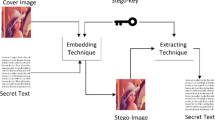Abstract
Embedding a secret message into the pixels of a cover image yields a visual distortion if these pixels belong to smooth regions. Thus, this prompted the development of some edge-based approaches in which only the edge pixels are used to hide secret bits. As a result, the visual quality of stego images is improved. However, the capacity is limited due to some unused regions in cover images. In this paper, an adaptive multi bit-planes image steganography using block data-hiding (MPBDH) is proposed. This method employs more than one bit-plane and applies an adaptive complexity threshold computation to select the complex regions of a cover image used in data hiding. Consequently, the embedding capacity and security performance are significantly improved in comparison with previous approaches based on pixel and block complexity. The results, which are obtained from experiments performed on 10,000 natural gray-images, indicate that the embedding capacity and security introduced in the proposed approach overcome the problems of previous approaches. The proposed approach is hence suitable for secure communications.








Similar content being viewed by others
References
(1997) SIPI Image Database. http://sipi.usc.edu/database/. Accessed 24 Jan 2015
Battisti F, Cancellaro M, Boato G et al (2009) Joint watermarking and encryption of color images in the fibonacci-haar domain. EURASIP J Adv Signal Process 2009:938515. doi:10.1155/2009/938515
Cachin C (1998) An information-theoretic model for steganography. inf. hiding. Springer, Berlin, pp 306–318
Chang K-C, Huang PS, Te-Ming Tu, Chien-Ping Chang (2007) Adaptive image steganographic scheme based on Tri-way Pixel-Value Differencing. IEEE, 1165–1170
Daemen J, Rijmen V (2002) The design of Rijndael AES - the advanced encryption standard. Springer, Berlin
Fridrich J, Goljan M, Du R (2001) Reliable detection of LSB steganography in color and grayscale images. ACM Press, 27
Hashemi Pour A (2012) A new steganography method based on the complex pixels. J Inf Secur 03:202–208. doi:10.4236/jis.2012.33025
Hirohisa H (2002) A data embedding method using BPCS principle with new complexity measures. Proc Pac. Rim Workshop Digit. Steganography. 30–47
Hong W (2012) Human visual system based data embedding method using quadtree partitioning. Signal Process Image Commun 27:1123–1133. doi:10.1016/j.image.2012.09.002
Jung K-H, Yoo K-Y (2014) Data hiding using edge detector for scalable images. Multimed Tools Appl 71:1455–1468. doi:10.1007/s11042-012-1293-8
Kawaguchi E, Eason RO (1998) Principle and applications of BPCS-steganography
Ker AD (2005) Steganalysis of LSB matching in grayscale images. IEEE Signal Process Lett 441–444. doi:10.1109/LSP.2005.847889
Kodovsky J, Fridrich J, Holub V (2012) Ensemble classifiers for steganalysis of digital media. IEEE Trans Inf Forens Secur 7:432–444. doi:10.1109/TIFS.2011.2175919
Luo W, Huang F, Huang J (2010) Edge adaptive image steganography based on lsb matching revisited. IEEE Trans Inf Forens Secur 5:201–214. doi:10.1109/TIFS.2010.2041812
Mielikainen J (2006) LSB matching revisited. IEEE Signal Process Lett 13:285–287. doi:10.1109/LSP.2006.870357
Muñoz A (2007) StegSecret. A simple steganalysis tool. http://stegsecret.sourceforge.net/. Accessed 24 Jan 2015
Nguyen TD, Arch-int S, Arch-int N (2014) A novel secure block data-hiding algorithm using cellular automata to enhance the performance of JPEG steganography. Multimed Tools Appl. doi:10.1007/s11042-014-1877-6
Pevny T, Bas P, Fridrich J (2010) Steganalysis by subtractive pixel adjacency matrix. IEEE Trans Inf Forens Secur 5:215–224. doi:10.1109/TIFS.2010.2045842
Qi H, Zheng D, Zhao J (2008) Human visual system based adaptive digital image watermarking. Signal Process 88:174–188. doi:10.1016/j.sigpro.2007.07.020
Rivest RL, Shamir A, Adleman LM (1983) Cryptographic communications system and method. Google Patents
Rose NJ (2001) Hilbert-type space-filling curves
Sabeti V, Samavi S, Shirani S (2013) An adaptive LSB matching steganography based on octonary complexity measure. Multimed Tools Appl 64:777–793. doi:10.1007/s11042-011-0975-y
Sur A, Ramanathan V, Mukherjee J (2014) Pixel rearrangement based statistical restoration scheme reducing embedding noise. Multimed Tools Appl 68:805–825. doi:10.1007/s11042-012-1078-0
Tomáš Pevný, Tomáš Filler, Patrick Bas (2013) Break Our Steganography System. s. Accessed 24 Jan 2015
Voloshynovskiy S, Herrigel A, Baumgaertner N, Pun T (2000) A Stochastic Approach to Content Adaptive Digital Image Watermarking. In: Pfitzmann A (ed) Inf. Hiding. Springer, Berlin, pp 211–236
Wang Z, Bovik AC, Sheikh HR, Simoncelli EP (2004) Image quality assessment: from error measurement to structural similarity. IEEE Trans Image Process 13:600–612
Westfeld A, Pfitzmann A (2000) Attacks on Steganographic Systems. In: Pfitzmann A (ed) Inf. Hiding. Springer, Berlin, pp 61–76
Acknowledgments
We gratefully acknowledge Department of Computer Science for financial support and Khon Kaen University for their assistance.
Author information
Authors and Affiliations
Corresponding author
Rights and permissions
About this article
Cite this article
Nguyen, T.D., Arch-int, S. & Arch-int, N. An adaptive multi bit-plane image steganography using block data-hiding. Multimed Tools Appl 75, 8319–8345 (2016). https://doi.org/10.1007/s11042-015-2752-9
Received:
Revised:
Accepted:
Published:
Issue Date:
DOI: https://doi.org/10.1007/s11042-015-2752-9




